Accepted Scientific Name: Orbea araysiana (Lavranos & Bilaidi) Bruyns
Aloe 37: 73 2000
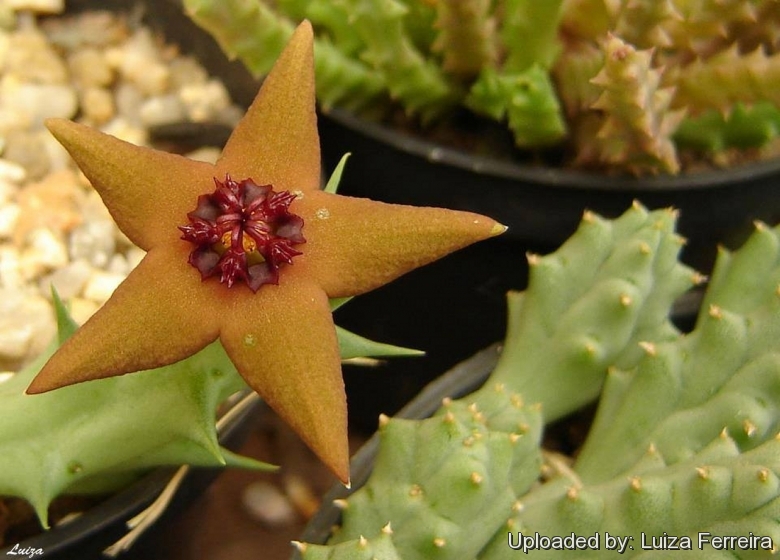
Pachycymbium araysianum (Orbea araysiana) Photo by: Luiza Ferreira
Origin and Habitat: South Yemen.
Type: South Yemen, Jabal al Arays
Synonyms:
Description: Orbea araysianaSN|30637]]SN|30637]] is a leafless dwarf perennial leaf-succulent species, spreading and forming dense above ground clusters up to 30 cm in diameter, not rhizomatous. The star-like flowers have bright red-brown, shiny slender lobes.
Distinguishing characteristics: O. araysiana is unique in its peculiarly long and slender inner-corona lobes, which ascent in the eye of the flowers in a column well higher up the level of the anthers.
Stems: Decumbent, erect at their apices, 2-8 cm long, 10-12 mm in diameter, (excluding teeth), 4-angled with conical teeth, greyish-green also with purple-brown spots. Tubercles 5-12 mm long, well spaced with a very slight groove between them, spreading to ascending, conical, tapering to a very fine point, occasionally with stipular denticles.
Inflorescences: 1 to 4 per stem mainly in the upper half, each with 1-3 flowers, peduncle absent, with 1-2 small acuminate bracts. Pedicel 6-12 mm long, 2 mm in diameter, spreading and then sometimes ascending or descending, holding flower facing upwards to downwards.
Flowers: Star-like, relatively flat, with slender lobes. Sepals 4-8 mm long, 1 mm wide at base, lanceolate, acute. Corolla bell-shaped, 10-17 mm long, 22-35 cm across; outside surface greyish-green to cream with fine longitudinal brown stripes tuberculed; inside pale to golden-yellow, olive-green, yellow suffused with brown or red-brown, becoming paler towards base of tube, shiny, slightly longitudinally rugulose on lobes, hairless or with low papillae on lobes and on side of tube, each papilla usually tipped with a white transparent bristle up to 1.5 mm long. Tube 5-12 mm long, 5-8 mm in diameter, cup-shapd, circular around mouth, becoming pentagonal towards base. Lobes slender, more or less ovate, 7-13 mm long, 4.5-7.0 mm wide at base, ascending to spreading margins rounded. Corona 6-7 mm tall, inner lobes much exceeding anthers and diverging above them.
Fruits (paired follicles): Slightly diverging, fusiform, acute, glabrous, smooth, densely streaked with dark purple-brown on a pale ground colour.
Bibliography: Major references and further lectures
1) John Hunter Thomas “Systematic Botany Monographs” American Society of Plant Taxonomists, 2002
2) Clive Innes “Complete Handbook of Cacti and Succulents” Van Nostrand Reinhold Company, 01 December 1981
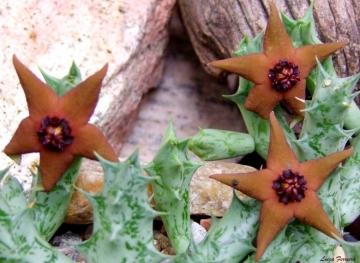 Pachycymbium araysianum (Orbea araysiana) Photo by: Luiza Ferreira
Pachycymbium araysianum (Orbea araysiana) Photo by: Luiza Ferreira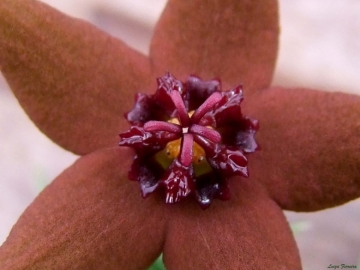 Pachycymbium araysianum (Orbea araysiana) Photo by: Luiza Ferreira
Pachycymbium araysianum (Orbea araysiana) Photo by: Luiza Ferreira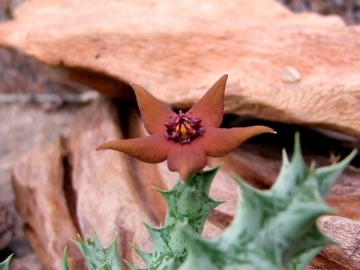 Pachycymbium araysianum (Orbea araysiana) Photo by: Luiza Ferreira
Pachycymbium araysianum (Orbea araysiana) Photo by: Luiza Ferreira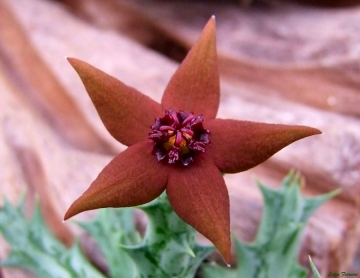 Pachycymbium araysianum (Orbea araysiana) Photo by: Luiza Ferreira
Pachycymbium araysianum (Orbea araysiana) Photo by: Luiza FerreiraCultivation and Propagation: Orbea araysianaSN|30637]]SN|30637]] is an easy blooming plant when mature that require moderately watering through the growing season but enjoy plenty of water and some fertiliser in hot weather, this helps them to flower freely. Water more sparingly in winter according to temperatures. But, as with most asclepiads, it is unwise to leave them wet in cold weather. Winter care presents no problems at 5°C with plenty of light. Since roots are quite shallow, use a cactus mix or add extra perlite or pumice to regular soil potting soil. A gritty, very free-draining compost is suitable, and clay pots help the plants to dry out between watering.
Sun Exposure: Partial sun or light shade
Pest and diseases: Orbea species vary in their susceptibility to rotting, but are generally fairly easy to grow, especially if kept pest-free. They are very susceptible to stem and root mealy bugs, and damage from these may well initiate fungal attack. If you do have problems with a stem or with basal rotting, you can reliably isolate the healthy parts, dry them off, and re-root them in moist compost.
Cultural Practices: Re-pot every 2 years.
Traditional uses: In Tanzania the sap from the pounded stems in applied to wounds and ulcers.
Propagation: Easiest with stem cuttings. Allow cuttings to dry a day before planting. Stems must be laid (Not buried) on gritty compost and will then root from the underside of the stems. It can also be increased from seeds sowing in spring in moist, sandy peat moss.
Potting medium: Since roots are quite shallow, use a cactus mix or add extra perlite or pumice to regular soil potting soil. A gritty, very free-draining compost is suitable, and clay pots help the plants to dry out between watering.














